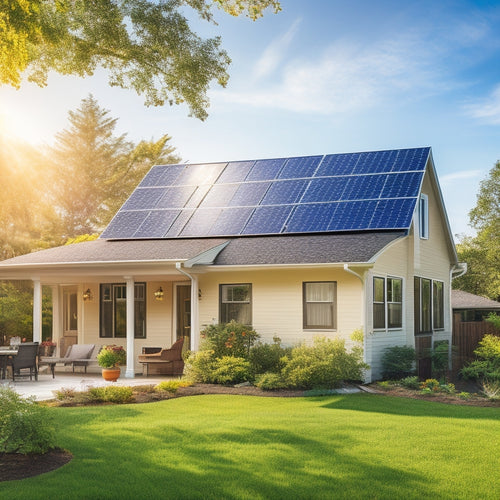
7 Essential Steps for a Smooth Installation Process
Share
You'll greatly reduce the risk of project delays, cost overruns, and performance issues by following a structured approach to installation. This involves seven essential steps that guarantee a smooth and successful setup. First, assess the site conditions and plan your installation strategy. Next, obtain necessary permits and assure compliance with regulations. Then, select and procure equipment, prepare your installation team, and install and test the system. After that, inspect and quality-check the system, and finally, test and commission it. By following these steps, you'll be well on your way to a trouble-free installation - and exploring these steps in more detail will reveal even more benefits.
Key Takeaways
• Conduct thorough site assessments to identify potential obstacles and develop a well-planned installation strategy.
• Obtain necessary permits and ensure compliance with relevant regulations to avoid costly rework and legal issues.
• Select equipment based on technical specifications, vendor reputation, and cost-benefit analysis to optimize budget and ensure timely delivery.
• Equip the installation team adequately, ensure they are well-versed in the installation process, and focus on clear communication and positive team dynamics.
• Prioritize system integration, network optimization, and quality control to ensure the installed system meets required specifications and performs smoothly.
Site Assessment and Planning
You must thoroughly assess the site conditions and identify potential obstacles before commencing the installation process to guarantee a smooth and successful outcome. This involves considering Landscaping Considerations, such as existing vegetation, drainage, and soil type, which can impact the installation process.
Environmental Factors, including climate, wind direction, and natural light exposure, should also be evaluated to make certain the installation is tailored to the site's specific conditions. By doing so, you'll be able to anticipate and mitigate potential challenges, saving time and resources in the long run.
A thorough site assessment will enable you to develop a well-planned installation strategy, ensuring a successful and efficient project execution.
Permitting and Compliance
Obtaining necessary permits and guaranteeing compliance with relevant regulations is a critical step in the installation process, as it prevents costly delays and potential legal issues.
You must navigate the regulatory framework to identify the required permits and licenses for your project. Code Enforcement agencies will scrutinize your application, so it's crucial to provide accurate and complete information. Failure to comply can result in project delays, fines, or even project cancellation.
You should also make sure that your installation meets the required standards and codes, avoiding any potential risks or hazards. By prioritizing permitting and compliance, you'll avoid costly rework and ensure a smooth installation process.
Equipment Selection and Procurement
Selecting the right equipment for your installation project is essential, as it directly impacts performance, efficiency, and overall success. You must consider factors such as compatibility, scalability, and reliability to guarantee a smooth installation process. Effective vendor management is pivotal in this stage, as it helps you negotiate the best deals, optimize your budget, and ensure timely delivery.
| Equipment Selection Criteria | Description |
|---|---|
| Technical Specifications | Make sure equipment meets project requirements |
| Vendor Reputation | Assess vendor credibility and reliability |
| Cost-Benefit Analysis | Evaluate equipment cost versus performance benefits |
Installation Team Preparation
Properly preparing your installation team is essential for a successful project outcome. It's important to equip them adequately before moving forward. You want to guarantee that your team is well-versed in the installation process, familiar with the equipment, and aware of the project timeline. This will help prevent delays, miscommunication, and costly mistakes.
To achieve this, focus on the following key areas:
-
Develop a clear communication strategy to make sure team members are informed and aligned throughout the project.
-
Foster positive team dynamics by encouraging collaboration, open feedback, and constructive criticism.
-
Provide thorough training on equipment operation, safety protocols, and installation procedures.
- Establish clear roles and responsibilities to avoid confusion and overlapping work.
System Installation and Testing
With your installation team prepared, you can now begin the system installation, which involves carefully executing the design plan and integrating all components to guarantee smooth functionality. This phase is critical, as it directly impacts the overall performance of your system. To make sure a smooth installation, focus on system integration, ensuring that all components work harmoniously together. Additionally, prioritize network optimization to minimize latency and maximize throughput.
| Component | Integration Step | Optimization Goal |
|---|---|---|
| Server | Configure server settings | Minimize latency |
| Network Devices | Connect and test devices | Maximize throughput |
| Software | Install and configure software | Ensure seamless functionality |
Inspection and Quality Control
You've completed the system installation, and now it's time to verify that every component is functioning as intended, which is where inspection and quality control come into play. This critical step guarantees that your system meets the required specifications and standards.
Here are some key aspects to focus on during inspection and quality control:
-
Inspect for material defects or damage during transportation, storage, or installation
-
Verify that all components are genuine and sourced from authorized suppliers in the supply chain
-
Check for any signs of wear, corrosion, or other forms of degradation
- Document and address any discrepancies or issues found during the inspection process
Final Testing and Commissioning
After verifying the system's components and addressing any discrepancies, it's time to energize the system and perform final testing and commissioning to guarantee it operates within specified parameters.
You'll need to conduct thorough system validation to make sure the system meets the required standards. This involves running a series of tests to verify that the system functions as intended.
Performance optimization is also vital at this stage, as it allows you to fine-tune the system to achieve peak performance. By doing so, you'll be able to identify and rectify any issues, ensuring a seamless and efficient operation.
Frequently Asked Questions
How Do I Handle Unexpected Site Discoveries During Installation?
When unexpected site discoveries arise, you'll be prepared with contingency planning and risk assessment strategies in place, enabling you to adapt quickly and make informed decisions to mitigate potential project disruptions.
Can I Reuse Existing Infrastructure to Reduce Installation Costs?
"Did you know 60% of projects exceed budget due to infrastructure surprises? To reduce installation costs, you'll need to conduct an infrastructure audit and cost analysis to determine what existing infrastructure can be reused, and what requires replacement or upgrade."
What if the Installation Team Lacks Experience With the Technology?
You identify knowledge gaps in the installation team and fill them with targeted training programs, ensuring they're equipped to handle the technology, and you're in control of the installation process from start to finish.
How Do I Minimize Downtime During the Installation Process?
To minimize downtime, you'll develop a contingency planning strategy, identifying potential risks and creating backup plans. Establish a clear communication strategy, ensuring all stakeholders are informed and aligned, allowing for swift issue resolution and reduced downtime.
Are There Any Post-Installation Maintenance Requirements I Should Know?
"Did you know 60% of system failures occur due to neglecting regular maintenance? You'll want to prioritize system updates and performance monitoring to prevent issues, ensuring your system runs smoothly and efficiently, giving you total control."
Related Posts
-

Off-Grid Solar Solutions for Sustainable Farming
Off-grid solar solutions can revolutionize your farming operations by providing energy independence and significant c...
-

How to Finance Home Solar Panels
Financing home solar panels offers several strategies to lighten your initial costs while maximizing long-term benefi...
-

Solar Inverter Troubleshooting for Beginners
Troubleshooting your solar inverter starts with understanding its efficiency and performance metrics. Check for prope...


